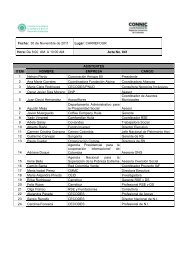Setting new standards - Friends Life
Setting new standards - Friends Life
Setting new standards - Friends Life
You also want an ePaper? Increase the reach of your titles
YUMPU automatically turns print PDFs into web optimized ePapers that Google loves.
INTERNATIONAL LIFE & PENSIONS ASSET MANAGEMENT GROUP FINANCIAL PERFORMANCE CONCLUSIONS AND OUTLOOK<br />
Our view of the market<br />
In 2006 the asset management industry benefited from a year of positive returns in the<br />
major asset classes. Despite a sharp correction in equities in May, markets staged a<br />
remarkably rapid recovery. The outlook for 2007 is one of slowing economic growth and<br />
an easing of inflationary pressures. This benign backdrop should be broadly supportive<br />
of equities, although we believe that returns are unlikely to be as high as those<br />
experienced in 2006. A key risk is a more pronounced deterioration in the US than<br />
expected. We also anticipate that volatility will rise from the low levels seen in 2006.<br />
Merger & Acquisition (M&A) activity was a significant feature of markets during 2006 as<br />
companies have shifted their focus from balance sheet strengthening to aggressive<br />
growth. An injection of private equity cash has also helped fuel M&A activity, with deals<br />
increasingly taking place at the upper end of the market cap spectrum.<br />
The asset management industry itself was not immune to this upsurge in corporate<br />
activity, with a number of sizeable transactions during 2006 as well as an expansion of<br />
the listed asset management sector. We envisage corporate activity remaining an<br />
industry trend, with drivers including the continued move towards ‘open architecture’ by<br />
financial services institutions, notably banks, building societies and insurance<br />
companies. As these businesses re-focus on distribution, there is greater willingness to<br />
use multiple external asset managers in their product ranges.<br />
UK equity market performance<br />
FTSE 100 Index<br />
2006 6,221<br />
2005 5,619<br />
2004 4,814<br />
2003 4,477<br />
UK Government bond market performance<br />
FTA Brit. Govt. fixed all stocks total return<br />
2006 1,949<br />
2005 1,935<br />
2004 1,793<br />
2003 1,682<br />
Note: All graphs are as at 31 December<br />
In the UK, firms of Independent Financial Advisers are also scaling up to meet the<br />
challenge of the <strong>new</strong> distribution landscape. This has led to both increasing sectoral<br />
consolidation and the emergence of <strong>new</strong> entrants. The top tier of investment advisers<br />
are increasingly developing discretionary services while the broad adviser market is<br />
making more use of multi-manager products. Fund supermarkets are now widely used<br />
by IFAs and we anticipate that the use of wrap accounts will gather pace. Access to the<br />
retail market is therefore about positioning on these platforms and servicing distribution<br />
relationships in addition to the prerequisites of strong investment performance<br />
supported by a credible brand.<br />
The developments of the last few years in the institutional market continue to gather<br />
pace. The UK has seen a shift over a number of years away from balanced<br />
management towards the separation of ‘alpha’ and ‘beta’ and increasing use of<br />
specialist mandates, and this continues. A comparable trend towards specialist<br />
mandates is now emerging in The Netherlands, Europe’s second largest pensions<br />
market, with a number of schemes moving towards a fiduciary model where a third<br />
party manager determines asset allocation, risk budgeting and underlying manager<br />
selection. This development poses a significant risk to balanced management in The<br />
Netherlands. In addition, across a number of developed markets there is a much greater<br />
focus on ensuring that pension scheme assets are sufficient to match their liabilities.<br />
This is driving interest in Liability Driven Investment (LDI) and Asset Liability<br />
Management (ALM).<br />
Together, these market changes are leading to demand for multi-management capabilities,<br />
LDI products, active added value ‘alpha’ products and alternative investments. Many of<br />
these trends require asset managers to deepen their derivatives expertise.<br />
This demand for more specialist products is prompting asset managers to evolve their<br />
business models accordingly. ‘House’ processes and top down investment leadership<br />
through a Chief Investment Officer are giving way to ‘multi-boutique’ investment<br />
models where investment teams have much greater accountability for specific products<br />
and processes, whilst leveraging off a common operational infrastructure. Likewise,<br />
remuneration is becoming more integrally linked to the performance of specific teams<br />
and the products that they manage.<br />
<strong>Friends</strong> Provident Annual Report & Accounts 2006 25

















